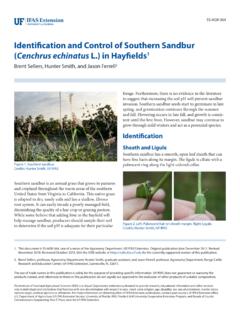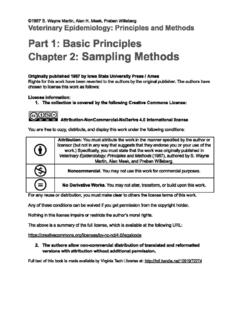Transcription of Basic Principles of Landscape Design1
1 1 This document is CIR536, one of a series of the Environmental Horticulture Department, UF/IFAS Extension. Original publication date July 2010. Reviewed September 2019. Visit the EDIS website at Gail Hansen, assistant professor, Environmental Horticulture Department, UF/IFAS Extension, Gainesville, FL Hansen2 Landscape designers work on a canvas that is distinctly different from other art forms. The art is always changing as the plants grow, environmental conditions change, and people use the space. For this reason, Landscape designers use a design process that systematically considers all aspects of the land, the environment, the growing plants, and the needs of the user to ensure a visually pleasing, functional, and ecologically healthy and principlesThe design process begins by determining the needs and desires of the user and the conditions of the site.
2 With this information, the designer then organizes the plants and hardscape materials, which are collectively referred to as the features. The features can be physically described by the visual qualities of line, form, color, texture, and visual weight the elements of design. The Principles are the fundamental concepts of composition proportion, order, repetition, and unity that serve as guidelines to arrange or organize the features to create an aesthetically pleasing or beautiful Landscape . Knowledge of the elements and Principles of design is essential to designing a Landscape and working through the design process. This publication describes each of the elements and explains the Principles and their of DesignThe elements of composition are the visual qualities that people see and respond to when viewing a space.
3 Visual qualities can illicit many different emotions and feelings, and the more positive those feelings, the more likely people are to enjoy and use a space. Perhaps the most common element in a composition is line. Line creates all forms and patterns and can be used in a variety of ways in the in the Landscape is created by the edge between two materials, the outline or silhouette of a form, or a long linear feature. Lines are a powerful tool for the designer because they can be used to create an infinite variety of shapes and forms, and they control movement of the eye and the body. Landscape designers use lines to create patterns, develop spaces, create forms, control movement, establish dominance, and create a cohesive theme in a Landscape .
4 Landscape lines are created several ways: when two different materials meet on the ground plane, such as the edge of a brick patio meeting an expanse of green turf; or when the edge of an object is visible or contrasts with a background, such as the outline of a tree against the sky; or by the placement of a material in a line, such as a fence. Figure 1 shows common Landscape lines, including bedlines, hardscape lines, path lines, sod lines, and fence lines. Lines can have one or more characteristics, such as those described below, but they typically serve different 1. Lines in the landscapeBasic Principles of Landscape Design1 2properties of linesThe properties of lines determine how people respond to the Landscape , both emotionally and physically.
5 Straight linesStraight lines are structural and forceful; they create a formal character, are usually associated with a symmetrical design, and lead the eye directly to a focal point. Diagonal lines are straight lines with an intentional direction. Straight lines are most often found in hardscape edges and linesCurved lines create an informal, natural, relaxed character that is associated more with nature and asymmetrical balance. Curved lines move the eye at a slower pace and add mystery to the space by creating hidden linesVertical lines move the eye up, making a space feel larger. An upward line can emphasize a feature and has a feeling of activity or movement. Vertical lines in the Landscape include tall, narrow plant material, such as trees, or tall structures, such as an arbor or a bird house on a linesHorizontal lines move the eye along the ground plane and can make a space feel larger.
6 Low lines are more subdued and create a feeling of rest or repose. Horizontal lines can spatially divide a space or tie a space together. Low lines are created by low garden walls, walkways, and short hedges. Lines are used to draw forms on a plan. In plan view, they define plant beds and hardscape areas. Lines are also created by the vertical forms of built features and plant material. There are three primary line types that create form in the Landscape : bedlines, hardscape lines, and plant lines. Bedlines are created where the edge of the plant bed meets another surface material, such as turf, groundcover, gravel, or patio pavers. Bedlines connect plant material to the house and hardscape because the eye follows the line, moving the gaze through the Landscape .
7 Hardscape lines are created by the edge of the hardscape, which delineates the built structure. Line can also be created by long and narrow materials, such as a fence or wall. formShape is created by an outline that encloses a space, and form is the three-dimensional mass of that shape. Form is found in both hardscape and plants, and it is typically the dominant visual element that spatially organizes the Landscape and often determines the style of the garden. The form of structures, plant beds, and garden ornaments also determines the overall form theme of the garden. Formal, geometric forms include circles, squares, and polygons. Informal, naturalistic forms include meandering lines, organic edges, and fragmented edges.
8 Plants create form in the garden through their outlines or silhouettes, but form can also be defined by a void or negative space between formscircular formCircles can be full circles, or they can be divided into half circles or circle segments and combined with lines to create arcs and tangents. Figure 2 shows the use of circle segments for hardscape and lawn panels. Circles can also be stretched into ovals and ellipses for more variety and interest. Circles are a strong design form because the eye is always drawn to the center, which can be used to emphasize a focal point or connect other 2. Circular forms in hardscape and lawn panelssquare formSquares are used for a variety of features, including stepping stones, bricks, tiles, and timber structures, because they are an easy form to work with for construction.
9 The square form can also be segmented and used repeatedly to create a grid pattern. Unlike circles, squares are stronger on the edges, which can be lined up or overlapped to create unique patterns and more complex polygonsPolygons are many-sided forms with straight edges. Triangles, for example, are three-sided polygons. The angled edges of polygons can make interesting shapes, but they should be used cautiously because the forms can become complex; simplicity is formsmeandering linesMeandering lines often mimic the natural course of rivers or streams and can be described as smooth lines with 3deeply curved undulations. Meandering lines (Figure 3) work well for pathways, plant bedlines, and dry stream beds.
10 Meandering lines can add interest and mystery to a garden by leading viewers around corners to discover new views and spaces. fiGurE 3. Meandering lines in the landscapeorganic edgesOrganic edges mimic the edges of natural material, such as foliage, plant forms, and rocks, and can be described as rough and irregular. Organic lines can be found in rock gardens and along dry creek beds or purposely created on hardscape 4. Organic edges: irregular edge of rock gardenfragmented edges Fragmented edges resemble broken pieces scattered from the edge, such as stones or pavers, and are often used to create a gradually disappearing edge on patios or 5. Fragmented edges: stepping stones in pathway plant formsForm is the most enduring quality of a plant.
















